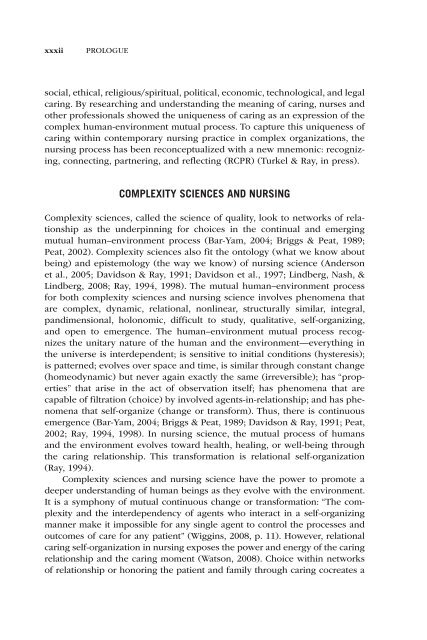Nursing, Caring, and Complexity Science: For Human ... - Axon
Nursing, Caring, and Complexity Science: For Human ... - Axon
Nursing, Caring, and Complexity Science: For Human ... - Axon
Create successful ePaper yourself
Turn your PDF publications into a flip-book with our unique Google optimized e-Paper software.
xxxii<br />
prologue<br />
social, ethical, religious/spiritual, political, economic, technological, <strong>and</strong> legal<br />
caring. By researching <strong>and</strong> underst<strong>and</strong>ing the meaning of caring, nurses <strong>and</strong><br />
other professionals showed the uniqueness of caring as an expression of the<br />
complex human-environment mutual process. To capture this uniqueness of<br />
caring within contemporary nursing practice in complex organizations, the<br />
nursing process has been reconceptualized with a new mnemonic: recognizing,<br />
connecting, partnering, <strong>and</strong> reflecting (RCPR) (Turkel & Ray, in press).<br />
<strong>Complexity</strong> <strong>Science</strong>s <strong>and</strong> <strong>Nursing</strong><br />
<strong>Complexity</strong> sciences, called the science of quality, look to networks of relationship<br />
as the underpinning for choices in the continual <strong>and</strong> emerging<br />
mutual human–environment process (Bar-Yam, 2004; Briggs & Peat, 1989;<br />
Peat, 2002). <strong>Complexity</strong> sciences also fit the ontology (what we know about<br />
being) <strong>and</strong> epistemology (the way we know) of nursing science (Anderson<br />
et al., 2005; Davidson & Ray, 1991; Davidson et al., 1997; Lindberg, Nash, &<br />
Lindberg, 2008; Ray, 1994, 1998). The mutual human–environment process<br />
for both complexity sciences <strong>and</strong> nursing science involves phenomena that<br />
are complex, dynamic, relational, nonlinear, structurally similar, integral,<br />
p<strong>and</strong>imensional, holonomic, difficult to study, qualitative, self-organizing,<br />
<strong>and</strong> open to emergence. The human–environment mutual process recognizes<br />
the unitary nature of the human <strong>and</strong> the environment—everything in<br />
the universe is interdependent; is sensitive to initial conditions (hysteresis);<br />
is patterned; evolves over space <strong>and</strong> time, is similar through constant change<br />
(homeodynamic) but never again exactly the same (irreversible); has “properties”<br />
that arise in the act of observation itself; has phenomena that are<br />
capable of filtration (choice) by involved agents-in-relationship; <strong>and</strong> has phenomena<br />
that self-organize (change or transform). Thus, there is continuous<br />
emergence (Bar-Yam, 2004; Briggs & Peat, 1989; Davidson & Ray, 1991; Peat,<br />
2002; Ray, 1994, 1998). In nursing science, the mutual process of humans<br />
<strong>and</strong> the environment evolves toward health, healing, or well-being through<br />
the caring relationship. This transformation is relational self-organization<br />
(Ray, 1994).<br />
<strong>Complexity</strong> sciences <strong>and</strong> nursing science have the power to promote a<br />
deeper underst<strong>and</strong>ing of human beings as they evolve with the environment.<br />
It is a symphony of mutual continuous change or transformation: “The complexity<br />
<strong>and</strong> the interdependency of agents who interact in a self-organizing<br />
manner make it impossible for any single agent to control the processes <strong>and</strong><br />
outcomes of care for any patient” (Wiggins, 2008, p. 11). However, relational<br />
caring self-organization in nursing exposes the power <strong>and</strong> energy of the caring<br />
relationship <strong>and</strong> the caring moment (Watson, 2008). Choice within networks<br />
of relationship or honoring the patient <strong>and</strong> family through caring cocreates a
















